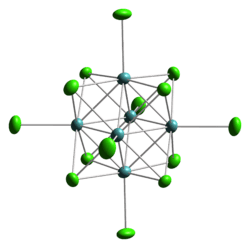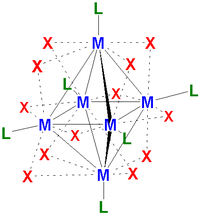Octahedral cluster
Octahedral clusters are inorganic or organometallic cluster compounds composed of six metals in an octahedral array.[1] Many types of compounds are known, but all are synthetic.
Octahedral chalcogenide and halide clusters
These compounds are bound together by metal-metal bonding as well as two kinds of ligands. Ligands that span the faces or edges of the M6 core are labeled Li, for inner (innen in the original German description), and those ligands attached only to one metal are labeled outer, or La for ausser.[2] Typically, the outer ligands can be exchanged whereas the bridging ligands are more inert toward substitution.
Face-capped halide clusters
The premier example is of the class is Mo6Cl142−. This dianion is available as a variety of salts by treating the polymer molybdenum(II) chloride with sources of chloride, even hydrochloric acid. A related example is W6I142− anion, which is obtained by reaction of tungsten hexacarbonyl with iodine at elevated temperatures.

Chalcohalide clusters
A related class of octahedral clusters are of the type M6X8L6 where M is a metal usually of group 6 or group 7, X is a ligand and more specifically an inner ligand of the chalcohalide group such as chloride or sulfide and L is an "outer ligand." The metal atoms define the vertices of an octahedron. The overall point group symmetry is Oh. Each face of the octahedron is capped with a chalcohalide and eight such atoms are at the corners of a cube. For this reason this geometry is called a face capped octahedral cluster. Examples of this type of clusters are the Re6S8Cl64− anion
Chevrel clusters
A well-studied class of solid-state compounds related to the chalcohalides are molybdenum clusters of the type AxMo6X8 with X sulfur or selenium and Ax an interstitial atom such as Pb. These materials, called Chevrel phases or Chevrel clusters, have been actively studied because they are type II superconductors with relatively high critical fields.[3] Such materials are prepared by high temperature (1100 °C) reactions of the chalcogen and Mo metal. Structurally related, soluble analogues have been prepared, e.g., Mo6S8(PEt3)6.[4]
Edge-Capped Halide Clusters
With metals in group 4 or 5 a so-called edge-capped octahedral clusters are more common. Twelve halides are located along the edge of the octahedron and six are terminal. Example of this type of species are the anion Ta6Cl184−.,[5] Nb6F15 or the Nb6F182− anion.[1]

Many of the early metal clusters can only be prepared when they incorporate intertitial atoms. One example is Zr6CCl12.[2]
Electron counting in octahedral halide and chalcogenide clusters
The species Mo6Cl142− feature Mo(II) (d4) centers. Six Mo(II) centers gives rise to a total of 24 valence electrons, or 2e/Mo-Mo vector. More electron-deficient derivatives such as Ta6Cl184− have fewer d-electrons. For example, the naked cluster Ta614+, the core of Ta6Cl184− would have 5(6) - 14 = 16 valence electrons. Fewer d-electrons result in weakened M-M bonding and the extended Ta---Ta distances accommodate doubly bridging halides.
Other classes of octahedral clusters
In the area of metal carbonyl clusters, a prototypical octahedral cluster is [Fe6C(CO)16]2−, which is obtained by heating iron pentacarbonyl with sodium. Some of the CO ligands are bridging and many are terminal. A carbide ligand resides at the center of the cluster. A variety of analogous compounds have been reported where some or all of the Fe centres are replaced by Ru, Mn and other metals.
Outside of carbonyl clusters, gold forms octahedral clusters.
6.png)
References
- 1 2 Eric J. Welch and Jeffrey R. Long Atomlike Building Units of Adjustable Character: Solid-State and Solution Routes to Manipulating Hexanuclear Transition Metal Chalcohalide Clusters in Progress in Inorganic Chemistry, Volume 54 Kenneth D. Karlin ISBN 0-471-72348-7 2005 Link
- 1 2 Arndt Simon "Metal clusters inside out" Phil. Trans. R. Soc. A 2010 vol. 368, 1285-1299. doi:10.1098/rsta.2009.0271
- ↑ Greenwood, Norman N.; Earnshaw, Alan (1997). Chemistry of the Elements (2nd ed.). Butterworth-Heinemann. ISBN 0-08-037941-9.
- ↑ Saito, T. and Imoto, H., "Chalcogenide Cluster Complexes of Chromium, Molybdenum, Tungsten, and Rhenium", Bulletin Chemical Society of Japan, 1996, volume 69, pp. 2403-2417. doi:10.1246/bcsj.69.2403
- ↑ Koknat, F. W.; Marko, D. J. "Tetradecachlorohexatantalum Octahydrate, Ta6Cl14.8H2O" Inorganic Syntheses, 2004, volume 34, pp. 187-191. ISBN 0-471-64750-0. (describes Na4Ta6Cl18)